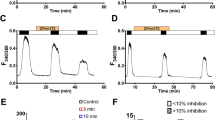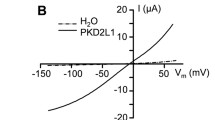Abstract
The cystic fibrosis transmembrane conductance regulator (CFTR) produces a cyclic adenosine monophosphate (cAMP)-dependent Cl- conductance of distinct properties that is essential for electrolyte secretion in human epithelial tissues. However, the functional consequences of CFTR expression are multifaceted, encompassing much more than simply supplying a cellular cAMP-regulated Cl- conductance. When we expressed CFTR in Xenopus oocytes, we found that extracellular acidic pH activates a Ca2+-dependent outwardly rectifying Cl- conductance that does not reflect CFTR activity. The proton-activated Cl- conductance showed biophysical and pharmacological features of a Ca2+-dependent Cl- conductance, most likely mediated by Xenopus TMEM16A. In contrast to the effects of extracellular acidification, intracellular acidification did not activate an endogenous Cl- conductance. Proton/CFTR-mediated activation of human TMEM16A was also detected in HEK293 cells. The gating mutant G551D-CFTR conferred proton sensitivity, while deltaF508-CFTR enabled proton activation of TMEM16A only in Xenopus oocytes, which, unlike HEK293 cells, allow deltaF508-CFTR to be trafficked to the cell membrane. Activation of TMEM16A by lysophosphatidic acid was enhanced in the presence of CFTR but was additive with activation by extracellular protons. Because expression of CFTR-E1474X did not confer proton sensitivity, we propose that CFTR translocates a proton receptor to the plasma membrane via its PDZ-binding domain.








Similar content being viewed by others
References
Amaral MD, Kunzelmann K (2007) Molecular targeting of CFTR as a therapeutic approach to cystic fibrosis. Trends Pharmacol Sci 28:334–341
Anderson MP, Welsh MJ (1991) Calcium and cAMP activate different chloride channels in the apical membrane of normal and cystic fibrosis epithelia. Proc Natl Acad Sci USA 88:6003–6007
Arnett T (2003) Regulation of bone cell function by acid–base balance. Proc Nutr Soc 62:511–520
Barro Soria R, AlDehni F, Almaca J, Witzgall R, Schreiber R, Kunzelmann K (2009) ER localized bestrophin1 acts as a counter-ion channel to activate Ca2+ dependent ion channels TMEM16A and SK4. Pflugers Arch 459:485–497
Bompadre SG, Sohma Y, Li M, Hwang TC (2007) G551D and G1349D, two CF-associated mutations in the signature sequences of CFTR, exhibit distinct gating defects. J Gen Physiol 129:285–298
Bronckers A, Kalogeraki L, Jorna HJ, Wilke M, Bervoets TJ, Lyaruu DM, Zandieh-Doulabi B, Denbesten P, De Jonge H (2010) The cystic fibrosis transmembrane conductance regulator (CFTR) is expressed in maturation stage ameloblasts, odontoblasts and bone cells. Bone 46:1188–1196
Caputo A, Caci E, Ferrera L, Pedemonte N, Barsanti C, Sondo E, Pfeffer U, Ravazzolo R, Zegarra-Moran O, Galietta LJ (2008) TMEM16A, a membrane protein associated with calcium-dependent chloride channel activity. Science 322:590–594
Chen JH, Cai Z, Sheppard DN (2009) Direct sensing of intracellular pH by the cystic fibrosis transmembrane conductance regulator (CFTR) Cl- channel. J Biol Chem 284:35495–35506
Dalemans W, Barbry P, Champigny G, Jallat S, Dott K, Dreyer D, Crystal RG, Pavirani A, Lecocq J-P, Lazdunski M (1992) Altered chloride ion channel kinetics associated with the deltaF508 cystic fibrosis mutation. Nature 354:526–528
Dawson DC, Smith SS, Mansoura MK (1999) CFTR: mechanism of anion conduction. Physiol Rev 79:S47–S75
Denning GM, Anderson MP, Amara JF, Marshall J, Smith AE, Welsh MJ (1992) Processing of mutant cystic fibrosis transmembrane conductance regulator is temperature-sensitive. Nature 358:761–764
Dif F, Marty C, Baudoin C, de Vernejoul MC, Levi G (2004) Severe osteopenia in CFTR-null mice. Bone 35:595–603
Doring G, Conway SP (2008) Osteoporosis in cystic fibrosis. J Pediatr 84:1–3
Drumm ML, Wilkinson DJ, Smit LS, Worrell RT, Strong TV, Frizzell RA, Dawson DC, Collins FS (1991) Chloride conductance expressed by deltaF508 and other mutant CFTRs in Xenopus oocytes. Science 254:1797–1799
Duffield MD, Rychkov GY, Bretag AH, Roberts ML (2005) Zinc inhibits human ClC-1 muscle chloride channel by interacting with its common gating mechanism. J Physiol 568:5–12
Ferrera L, Caputo A, Ubby I, Bussani E, Zegarra-Moran O, Ravazzolo R, Pagani F, Galietta LJ (2009) Regulation of TMEM16A chloride channel properties by alternative splicing. J Biol Chem 284:33360–33368
Grubb BR, Vick RN, Boucher RC (1994) Hyperabsorption of Na+ and raised Ca2+ mediated Cl- secretion in nasal epithelia of CF mice. Am J Physiol 266:C1478–C1483
Guggino WB, Stanton BA (2006) New insights into cystic fibrosis: molecular switches that regulate CFTR. Nat Rev Mol Cell Biol 7:426–436
Haston CK, Li W, Li A, Lafleur M, Henderson JE (2008) Persistent osteopenia in adult cystic fibrosis transmembrane conductance regulator-deficient mice. Am J Respir Crit Care Med 177:309–315
Henriksen K, Bollerslev J, Everts V, Karsdal MA (2011) Osteoclast activity and subtypes as a function of physiology and pathology — implications for future treatments of osteoporosis. Endocr Rev 32:31–63
Javier RM, Jacquot J (2011) Bone disease in cystic fibrosis: what’s new? Joint Bone Spine
Knowles MR, Clarke LL, Boucher RC (1991) Activation by extracellular nucleotides of chloride secretion in the airway epithelia of patients with cystic fibrosis. N Engl J Med 325:533–538
Kunzelmann K (2001) CFTR: interacting with everything? News Physiol Sci 17:167–170
Kunzelmann K (2011) Assessment of CFTR function. In: Cystic fibrosis: methods and protocols. In: Amaral M, Kunzelmann K (eds) Methods in molecular biology (in press) 2
Kunzelmann K, Kongsuphol P, AlDehni F, Tian Y, Ousingsawat J, Warth R, Schreiber R (2009) Bestrophin and TMEM16 — Ca2+ activated Cl- channels with different functions. Cell Calcium 46:233–241
Kunzelmann K, Mall M, Briel M, Hipper A, Nitschke R, Ricken S, Greger R (1997) The cystic fibrosis transmembrane conductance regulator attenuates the endogenous Ca2+ activated Cl- conductance in Xenopus ooyctes. Pflugers Arch 434:178–181
Kunzelmann K, Schreiber R, Cook DI (2002) Mechanisms for inhibition of amiloride-sensitive Na+ absorption by extracellular nuceotides in mouse trachea. Pflugers Arch 444:220–226
Li C, Dandridge KS, Di A, Marrs KL, Harris EL, Roy K, Jackson JS, Makarova NV, Fujiwara Y, Farrar PL, Nelson DJ, Tigyi GJ, Naren AP (2005) Lysophosphatidic acid inhibits cholera toxin-induced secretory diarrhea through CFTR-dependent protein interactions. J Exp Med 202:975–986
Li C, Krishnamurthy PC, Penmatsa H, Marrs KL, Wang XQ, Zaccolo M, Jalink K, Li M, Nelson DJ, Schuetz JD, Naren AP (2007) Spatiotemporal coupling of cAMP transporter to CFTR chloride channel function in the gut epithelia. Cell 131:940–951
Mall M, Gonska T, Thomas J, Schreiber R, Seydewitz HH, Kuehr J, Brandis M, Kunzelmann K (2003) Modulation of Ca2+ activated Cl- secretion by basolateral K+ channels in human normal and cystic fibrosis airway epithelia. Pediatr Res 53:608–618
Martins JR, Kongsuphol P, Sammels E, AlDehni F, Clarke L, Schreiber R, De Smedt H, Amaral MD, Kunzelmann K (2011) F508del-CFTR increases intracellular Ca2+ signaling that causes enhanced calcium-dependent Cl- conductance in cystic fibrosis. Acta Physiol Scand (Abtract) 201S682:P271
Namkung W, Thiagarajah JR, Phuan PW, Verkman AS (2010) Inhibition of Ca2+-activated Cl- channels by gallotannins as a possible molecular basis for health benefits of red wine and green tea. FASEB J 24:4178–4186
Naren AP, Cobb B, Li C, Roy K, Nelson D, Heda GD, Liao J, Kirk KL, Sorscher EJ, Hanrahan JW, Clancy JP (2003) A macromolecular complex of beta 2 adrenergic receptor, CFTR, and ezrin/radixin/moesin-binding phosphoprotein 50 is regulated by PKA. Proc Natl Acad Sci USA 100:342–346
Noh SJ, Kim MJ, Shim S, Han JK (1998) Different signaling pathway between sphingosine-1-phosphate and lysophosphatidic acid in Xenopus oocytes: functional coupling of the sphingosine-1-phosphate receptor to PLC-xbeta in Xenopus oocytes. J Cell Physiol 176:412–423
Oceandy D, McMorran BJ, Smith SN, Schreiber R, Kunzelmann K, Alton EWF, Hume DA, Wainwright BJ (2002) Gene complementation of airway epithelium in the cystic fibrosis mouse in necessary and sufficient to correct the pathogen clearance and inflammatory abnormalities. Hum Mol Genet 11:1059–1067
Ousingsawat J, Martins JR, Schreiber R, Rock JR, Harfe BD, Kunzelmann K (2009) Loss of TMEM16A causes a defect in epithelial Ca2+ dependent chloride transport. J Biol Chem 284:28698–28703
Paradiso AM, Ribeiro CM, Boucher RC (2001) Polarized signaling via purinoceptors in normal and cystic fibrosis airway epithelia. J Gen Physiol 117:53–68
Pashuck TD, Franz SE, Altman MK, Wasserfall CH, Atkinson MA, Wronski TJ, Flotte TR, Stalvey MS (2009) Murine model for cystic fibrosis bone disease demonstrates osteopenia and sex-related differences in bone formation. Pediatr Res 65:311–316
Penmatsa H, Zhang W, Yarlagadda S, Li C, Conoley VG, Yue J, Bahouth SW, Buddington RK, Zhang G, Nelson DJ, Sonecha MD, Manganiello V, Wine JJ, Naren AP (2010) Compartmentalized cAMP at the plasma membrane clusters PDE3A and CFTR into microdomains. Mol Biol Cell 21:1097–1100
Qu Z, Hartzell HC (2000) Anion permeation in Ca2+-activated Cl- channels. J Gen Physiol 116:825–844
Qu Z, Hartzell HC (2001) Functional geometry of the permeation pathway of Ca2+-activated Cl-channels inferred from analysis of voltage-dependent block. J Biol Chem 276:18423–18429
Rock JR, O’Neal WK, Gabriel SE, Randell SH, Harfe BD, Boucher RC, Grubb BR (2009) Transmembrane protein 16A (TMEM16A) is a Ca2+ regulated Cl- -secretory channel in mouse airways. J Biol Chem 284:14875–14880
Schreiber R, Uliyakina I, Kongsuphol P, Warth R, Mirza M, Martins JR, Kunzelmann K (2010) Expression and function of epithelial anoctamins. J Biol Chem 285:7838–7845
Schroeder BC, Cheng T, Jan YN, Jan LY (2008) Expression cloning of TMEM16A as a calcium-activated chloride channel subunit. Cell 134:1019–1029
Treharne KJ, Xu Z, Chen J-H, Best OG, Cassidy D, Gruenert DC, Hegyi P, Gray L, Sheppard DN, Kunzelmann K, Mehta A (2009) Inhibition of protein kinase CK2 closes the CFTR Cl- channel, but has no effect on the cystic fibrosis mutant F508-CFTR. Cell Physiol Biochem 24:347–360
Van der Wijk T, De Jonge HR, Tilly BC (1999) Osmotic cell swelling-induced ATP release mediates the activation of extracellular signal-regulated protein kinase (Erk)-1/2 but not the activation of osmo-sensitive anion channels. Biochem J 343(Pt 3):579–586
Wei L, Vankeerberghen A, Cuppens H, Eggermont J, Cassiman JJ, Droogmans G, Nilius B (1999) Interaction between calcium-activated chloride channels and the cystic fibrosis transmembrane conductance regulator. Pflugers Arch 438:635–641
Yang YD, Cho H, Koo JY, Tak MH, Cho Y, Shim WS, Park SP, Lee J, Lee B, Kim BM, Raouf R, Shin YK, Oh U (2008) TMEM16A confers receptor-activated calcium-dependent chloride conductance. Nature 455:1210–1215
Acknowledgment
We gratefully acknowledge the support by DFG SFB699A7, Mukoviszidose e.V. (Projekt-Nr. S02/10) and TargetScreen2 (EU-FP6-2005-LH-037365).
Author information
Authors and Affiliations
Corresponding author
Rights and permissions
About this article
Cite this article
Kongsuphol, P., Schreiber, R., Kraidith, K. et al. CFTR induces extracellular acid sensing in Xenopus oocytes which activates endogenous Ca2+-activated Cl- conductance. Pflugers Arch - Eur J Physiol 462, 479–487 (2011). https://doi.org/10.1007/s00424-011-0983-9
Received:
Revised:
Accepted:
Published:
Issue Date:
DOI: https://doi.org/10.1007/s00424-011-0983-9




